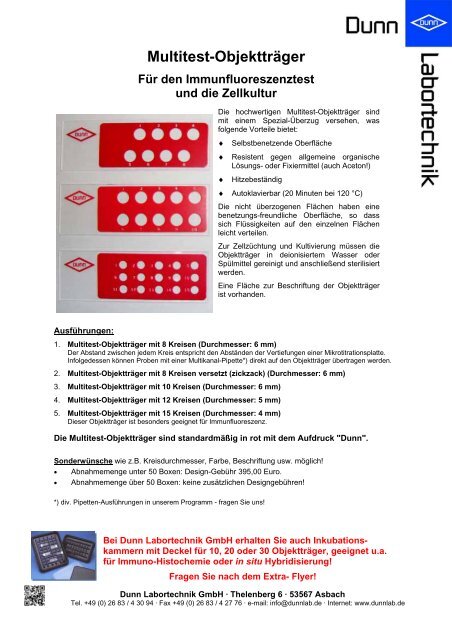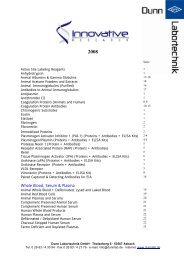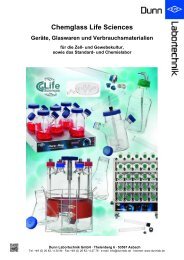Multitest-Objektträger - Dunn Labortechnik GmbH
Multitest-Objektträger - Dunn Labortechnik GmbH
Multitest-Objektträger - Dunn Labortechnik GmbH
- Keine Tags gefunden...
Erfolgreiche ePaper selbst erstellen
Machen Sie aus Ihren PDF Publikationen ein blätterbares Flipbook mit unserer einzigartigen Google optimierten e-Paper Software.
<strong>Multitest</strong>-ObjektträgerFür den Immunfluoreszenztestund die ZellkulturDie hochwertigen <strong>Multitest</strong>-Objektträger sindmit einem Spezial-Überzug versehen, wasfolgende Vorteile bietet:♦♦♦Selbstbenetzende OberflächeResistent gegen allgemeine organischeLösungs- oder Fixiermittel (auch Aceton!)Hitzebeständig♦ Autoklavierbar (20 Minuten bei 120 °C)Die nicht überzogenen Flächen haben einebenetzungs-freundliche Oberfläche, so dasssich Flüssigkeiten auf den einzelnen Flächenleicht verteilen.Zur Zellzüchtung und Kultivierung müssen dieObjektträger in deionisiertem Wasser oderSpülmittel gereinigt und anschließend sterilisiertwerden.Eine Fläche zur Beschriftung der Objektträgerist vorhanden.Ausführungen:1. <strong>Multitest</strong>-Objektträger mit 8 Kreisen (Durchmesser: 6 mm)Der Abstand zwischen jedem Kreis entspricht den Abständen der Vertiefungen einer Mikrotitrationsplatte.Infolgedessen können Proben mit einer Multikanal-Pipette*) direkt auf den Objektträger übertragen werden.2. <strong>Multitest</strong>-Objektträger mit 8 Kreisen versetzt (zickzack) (Durchmesser: 6 mm)3. <strong>Multitest</strong>-Objektträger mit 10 Kreisen (Durchmesser: 6 mm)4. <strong>Multitest</strong>-Objektträger mit 12 Kreisen (Durchmesser: 5 mm)5. <strong>Multitest</strong>-Objektträger mit 15 Kreisen (Durchmesser: 4 mm)Dieser Objektträger ist besonders geeignet für Immunfluoreszenz.Die <strong>Multitest</strong>-Objektträger sind standardmäßig in rot mit dem Aufdruck "<strong>Dunn</strong>".Sonderwünsche wie z.B. Kreisdurchmesser, Farbe, Beschriftung usw. möglich!• Abnahmemenge unter 50 Boxen: Design-Gebühr 395,00 Euro.• Abnahmemenge über 50 Boxen: keine zusätzlichen Designgebühren!*) div. Pipetten-Ausführungen in unserem Programm - fragen Sie uns!Bei <strong>Dunn</strong> <strong>Labortechnik</strong> <strong>GmbH</strong> erhalten Sie auch Inkubationskammernmit Deckel für 10, 20 oder 30 Objektträger, geeignet u.a.für Immuno-Histochemie oder in situ Hybridisierung!Fragen Sie nach dem Extra- Flyer!<strong>Dunn</strong> <strong>Labortechnik</strong> <strong>GmbH</strong> · Thelenberg 6 · 53567 AsbachTel. +49 (0) 26 83 / 4 30 94 · Fax +49 (0) 26 83 / 4 27 76 · e-mail: info@dunnlab.de · Internet: www.dunnlab.de
GEBRAUCHSANWEISUNGThe following information briefly explains in a step by step procedure the use of <strong>Multitest</strong> Slides for cellculture and immunofluorescence.CULTURE OF CELLS ON MULTITEST-SLIDES1. Rinse the slides briefly in a warm detergent solution (e.g.3% 7X), then successively in tap waterand deionised water.2. Sterilise the slides, preferably by using dry heat at 160 °C for 1 hour.3. Place the slides in the bottom of a 90 mm diameter sterile petri dish*).4. Prepare a suspension of cells in the appropriate medium at a concentration of approximately 5 x10 4 cells/ml. Dispense 25 ml of the cell suspension into each petri dish, then incubate in a humidatmosphere of 5% CO 2 /air mixture overnight. The cells will only attach to the uncoated wells.Alternatively:Place 30 - 50 µl of a cell-suspension in medium at a concentration of approximately1 x 10 5 cells/ml on each uncoated well. Incubate the cells in humified atmosphere for about 1 hourto let them pre-attach. Add 25 ml of the the appropriate medium into each petri dish, then incubatein a humid atmosphere of 5% CO 2 /air.5. When a confluent cell monolayer is achieved, the slides can be withdrawn from the petri dish andrinsed 2 - 3 times in successive charges of saline and then fixed. The method of fixation will varyaccording to the needs of the particular technique.PREPARATION OF CULTURED CELLS FOR IMMUNFLUORESCENCE (IFA) TESTSUSING MULTITEST SLIDES.1. Decant the culture medium from a vessel containing a confluent monolayer of cells and replace itwith Phosphate Buffered Saline (PBS) pH 7.2. Leave to soak for 10 minutes and then discard thePBS. Repeat the addition of fresh PBS at least three times.2. Add a further 10 ml of PBS to the vessel, then scrape the cells off surface using a rubber"Policeman" (cell scraper).3. Transfer the cell suspension obtained to a conical centrifuge tube*) and spin at 300 - 400 g for 10 -15 minutes. Resuspend the pellet in 10 ml of fresh PBS and centrifuge again.4. Finally, resuspend the cell suspension obtained in a minimal volume of PBS so that a milkycoloured suspension is obtained.5. Using a Pasteur pipette (or Multichannel Pipette*) dispense single drops of this cell suspensiononto the wells of the <strong>Multitest</strong> Slides.6. Incubate the slides at 60 °C until these drops evaporate to dryness.7. Flood the slides with ice-cold acetone for 1 - 2 minutes. Discard the acetone and replace withfresh cold acetone for a further 5 - 10 minutes.8. Air dry the slides. They are now ready for performing the IFA test. Alternatively, if the slides are tobe stored for later use, they can be sealed in a box with silica gel at -20 °C for several weeks.*) Petri dishes, tubes, pasteur, single and multichannel pipettes in our programme: pls. enquire!Kat.-Nr. Beschreibung VE40-408-06 8 Kreise, ∅ 6 mm 100/Box40-488-06 8 Kreise, versetzt, ∅ 6 mm 100/Box40-410-06 10 Kreise, ∅ 6 mm 100/Box40-412-05 12 Kreise, ∅ 5 mm 100/Box40-415-04 15 Kreise, ∅ 4 mm 100/Box40-302-04 10 Kreise, ∅ 4 mm 100/Box













